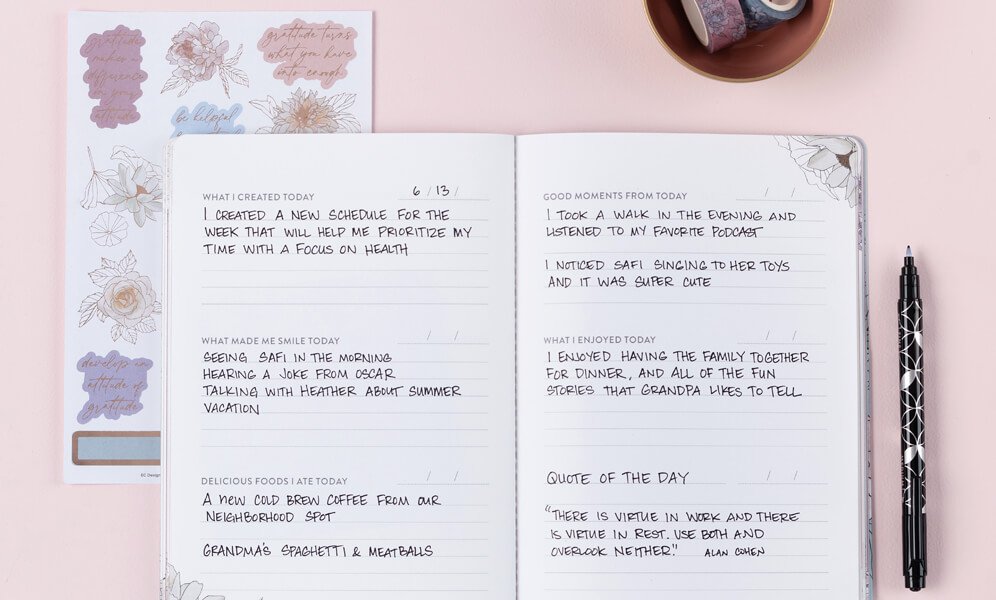How to Start a Gratitude Journal and Unlock the Power of Positivity

What if we told you from experience that the simple act of writing in a gratitude journal could positively impact your day in a real way? Throughout each day, we experience so many things to be thankful for: the homes and communities in which we live, food on our table, friends, and family — all of these make our lives worth living. Sometimes, though, we lose sight of what we have and focus on the negative aspects of our lives, getting caught up in life’s big and little disappointments.
Fortunately, there is a remedy for this tendency: practicing gratitude. Practicing gratitude means being intentional about recognizing those things that are going well for us, the resources we have, and the people we know. When we practice gratitude, we start to experience the world as a positive place and other people as human beings with whom we can have positive connections (this is particularly helpful if you care for children).
One way to tap into the power of gratitude is through the practice of keeping a gratitude journal. Gratitude is a powerful emotion (and self-care booster) that can positively impact our mental and physical health. By being intentional about what we focus on and exploring our thoughts, behaviors, and circumstances through a lens of gratitude, we can shift our mindset in a more positive, purposeful way. Again, if you care for children, modeling gratitude can pay dividends throughout their childhood and into adulthood (a powerful life lesson, tool, and gift you could give -- how wonderful is that?).
What Is a Gratitude Journal?
A gratitude journal is a tool for recording things you are thankful for each day. It can take the form of a notebook, journal, or even a digital app. The purpose of a gratitude journal is to help you cultivate a positive mindset by reflecting on the good things in your life.
You may also like How to Start Mindfulness Journaling + Why You Should.
The Benefits of Keeping a Gratitude Journal

There are numerous benefits to keeping a gratitude journal. Research has shown that practicing gratitude can improve our overall sense of well-being, increase happiness, and reduce stress and anxiety. By focusing on the positive aspects of our lives, we can reframe our mindset and become more resilient in the face of challenges.
Gratitude journaling is a simple but effective way to cultivate gratitude in your life. There are numerous benefits of keeping a gratitude journal, backed by science. In this section, we will expand on the benefits of gratitude journaling, providing 8 benefits supported by research.
Reduces Stress and Anxiety
Gratitude journaling can help to reduce stress and anxiety by shifting the focus from negative to positive thoughts. UC Davis Health Medical Center reports on the science of gratitude that participants who kept a daily gratitude journal for just two weeks reported reduced levels of stress and improved sleep quality.
Learn more about How to Journal to Reduce Stress and Meditation Journaling: Elevate Your Practice with Daily Reflections.
Boosts Happiness
When we focus on the good things in our lives, we naturally feel happier. Research.com reports findings that people who wrote letters of gratitude experienced a boost in happiness that lasted for up to a month.
Improves Relationships
Gratitude journaling can help to improve our relationships with others. When we reflect on the things we are grateful for, we often think about the people in our lives who have contributed to those things. This can help us appreciate and strengthen our relationships with others.
Increases Resilience
When we practice gratitude, we become more resilient in the face of challenges. A study published in the Journal of Positive Psychology: Neuroscience of Gratitude on the Brain found that people who practiced gratitude were more resilient in the face of trauma and had lower rates of depression and anxiety.
Improves Sleep Quality
Gratitude journaling can help to improve sleep quality by reducing stress and promoting positive emotions. A study published in Applied Psychology: Health and Well-Being found that people who kept a gratitude journal slept longer and had improved sleep quality compared to those who didn't.
Enhances Self-Esteem
When we reflect on the things we are grateful for about ourselves, we can boost our self-esteem. A study published in the Journal of Applied Sport Psychology found that athletes who practiced gratitude had higher levels of self-esteem and were more motivated to succeed.
Improves Physical Health
Gratitude journaling can have a positive impact on our physical health. A study published in the Journal of Personality and Social Psychology found that people who practiced gratitude had better self-care habits, such as exercising regularly and eating a healthy diet.
Promotes Positive Emotions
Gratitude journaling can help to promote positive emotions, such as joy, happiness, and contentment. A study published in the Journal of Positive Psychology found that people who practiced gratitude had higher levels of positive emotions and were more satisfied with their lives.
Gratitude journaling is a simple but powerful practice that can have a positive impact on our mental and physical health. By focusing on the good things in our lives, we can shift our mindset from one of negativity to one of positivity. The benefits of gratitude journaling are numerous, including reduced stress and anxiety, boosted happiness, improved relationships, increased resilience, improved sleep quality, enhanced self-esteem, improved physical health, and promoted positive emotions. By incorporating gratitude journaling into our daily routine, we can unlock the power of positivity and cultivate a more fulfilling and meaningful life.
Additionally, keeping a gratitude journal can help us cultivate a deeper sense of connection with others. When we reflect on the things we are grateful for, we often think about the people in our lives who have contributed to those things. This can help us appreciate and strengthen our relationships with others.
How to Start a Gratitude Journal
If you're interested in starting a gratitude journal, here are some tips to help you get started.
Choosing a Notebook or Journal

The first step is to choose a notebook or journal to use as your gratitude journal. You'll want to choose something that you enjoy writing in and that feels special to you. This could be a beautiful leather-bound (or vegan leather-bound) journal, a spiral notebook, or a guided journal.
Choosing a gratitude journal or notebook is an important step in starting your gratitude practice. There are many different types of journals to choose from, and it's important to find one that suits your needs and preferences. Here are five different types of gratitude journals and their specific uses to help you choose the right one for you:
Traditional Journal
A traditional journal is a classic choice for a gratitude journal. These journals typically have lined pages and a hardcover, making them durable and easy to write in. They come in a variety of sizes and designs, so you can choose one that fits your personal style. Traditional journals are a good choice for people who prefer a classic look and feel.
Gratitude Planner
A gratitude planner is a journal that is specifically designed for gratitude practice. These planners typically include prompts and exercises to help you cultivate gratitude, along with space for daily reflections. They often come with goal-setting pages and other tools to help you stay organized and focused. These guided planners are a good choice for people who want a more structured approach to gratitude journaling.
Guided Gratitude Journal
A guided gratitude journal provides prompts and exercises to help you cultivate gratitude. These journals often have daily prompts that encourage you to reflect on specific things you are grateful for, such as people, experiences, or possessions. Some guided journals also include quotes and affirmations to help you stay motivated and inspired. Guided gratitude journals are a good choice for people who want guidance and structure in their gratitude practice.
To learn more about guided journals, check out our Ultimate Guide to Guided Journals.
Art Journal
An art journal is a type of journal that incorporates visual art and creativity. These journals typically have blank pages that you can fill with drawings, collages, or other types of visual art. You can use an art notebook by creating a gratitude mandala or painting a picture of something you are thankful for. Art journals are a good choice for people who enjoy creative expression and want to incorporate art into their journaling.
Digital Journal
A digital journal is a journal that is stored on a computer or mobile device. These journals can be accessed through a variety of apps and software programs. While there are obvious conveniences associated with digital journals (like sharing across devices, reminders, etc.) there are many benefits of writing by hand and using a paper journal over a digital app. Those benefits include better stress relief, improved memory, decreased screen fatigue, and more. So weigh the pros and cons of paper vs digital when choosing which journal is best for you.
Choosing the right gratitude journal or notebook is an important part of starting your gratitude practice. By considering your personal preferences and needs, you can find a journal that will inspire and motivate you (whether it's a faith journal for spiritual practice or a journal for mental health and happiness in your daily life). No matter what type you choose, the important thing is to find a journal that works for you and helps you cultivate gratitude in your life.
Setting Up Your Gratitude Journal

Once you've chosen your journal, it's time to set it up. Some people like to create a cover page or write an introduction to their journal. You can also add prompts or quotes throughout the journal to inspire you.
What to Write in Your Gratitude Journal
The most important part of your gratitude journal is what you write in it. Each day, take a few minutes to reflect on the things you are grateful for. This could be anything from a kind gesture from a friend to a beautiful sunset you witnessed. Try to be as specific as possible and reflect on why you are grateful for each thing.
You can also use your gratitude journal to reflect on the positive things that have happened to you throughout the day. This could include small wins at work, moments of joy with your family, or even just a delicious meal you enjoyed.
How to Keep Gratitude Journaling Fun and Interesting
To make journaling more fun and interesting, try different approaches -- there's no right or wrong way! For example, you could create themed pages, such as "Grateful for Nature" or "Grateful for Relationships." You can also try using different writing prompts to stay inspired.
Another approach is to incorporate art or creativity into your journaling. This could be as simple as using colorful pens and markers or adding stickers to your pages, or as complex as creating full-blown art journal pages.
Check out these Fun Ways to Use a Blank Notebook to get the most out of your journaling journey!
How to Stay Motivated to Write in Your Gratitude Journal Regularly
To create any healthy habit, it's important to find ways to stay motivated. One approach is to set a specific time each day for writing about what you're grateful for. For example, you could write in your journal first thing in the morning or before bed each night. Whenever you dedicate time to adding a short journal entry, be sure it flows with your natural schedule so you can keep it up.
Another approach is to find an accountability partner. This could be a friend or family member who is also interested in practicing gratitude. You can check in with each other regularly to share your progress and keep each other motivated.
Finally, it's important to be kind to yourself if you miss a day or two of journaling. Remember that the purpose is to nurture a positive mindset, not to create additional stress or guilt. If you miss a day, simply pick up where you left off and continue with your practice.
Daily Gratitude Journaling Prompts
If you're struggling to come up with things to write, here are helpful prompts to get you started:
- What made you smile today?
- What is something you're looking forward to?
- Who is someone you are grateful for?
- What is something new you learned today?
- What is something you accomplished today?
- What is a small pleasure you enjoyed today?
- What is something beautiful you saw today?
- What is something you are grateful for about yourself?
- What is something that made you feel loved today?
- What is something you are grateful for about your home?
A gratitude journal is a self-care tool tool for recording things you are thankful for each day. It can help you cultivate a positive mindset and better self-awareness, increase happiness, reduce stress and anxiety, deepen your connections with others, and improve your overall well-being. (By focusing on the good things in your life, you can reframe your mindset and become more resilient in the face of challenges!) To start a gratitude journaling practice, choose a journal that inspires you, set it up in a way that feels special, and take a few minutes each day to reflect on the things you are grateful for via a brief journal entry. To keep your journaling practice fun and interesting, try different approaches such as themed pages, writing prompts, or incorporating art and creativity. Stay motivated by setting a specific time each day for journaling, finding an accountability partner, and being kind to yourself if you miss a day or two of journaling. With these tips in mind, you're ready to start unlocking the power of positivity with your own gratitude journal!
Remember to choose a journal that feels special and take a few minutes each day to reflect on the things you are grateful for. Discover for yourself the best gratitude journals and notebooks that you can customize and personalize. Happy journaling!
Related Journaling Guides
You may also enjoy these other popular, guided journaling tips, prompts, and inspiration from our experts:
- How to Do a Daily Gratitude Challenge + Why You Should
- How to Use a Line a Week Journal: A Comprehensive Guide + Prompts
- How to Start Mindfulness Journaling + Why You Should
- Journaling for Mental Health + Where to Start
- The Benefits of a Stress Relief Journal + How to Start One
- Wellness Journal Ideas
- Exploring Faith Through Journaling
- How to Use a Planner to Reduce Stress
- 20 Cute Things to Do with a Blank Notebook
- Guided Journals: Everything You Need to Know
- Meditation Journaling: Elevate Your Practice with Daily Reflections
- 8 Life-Changing Benefits of Journaling Before Bed + How to Start
- Journaling for Anxiety: How to Start
